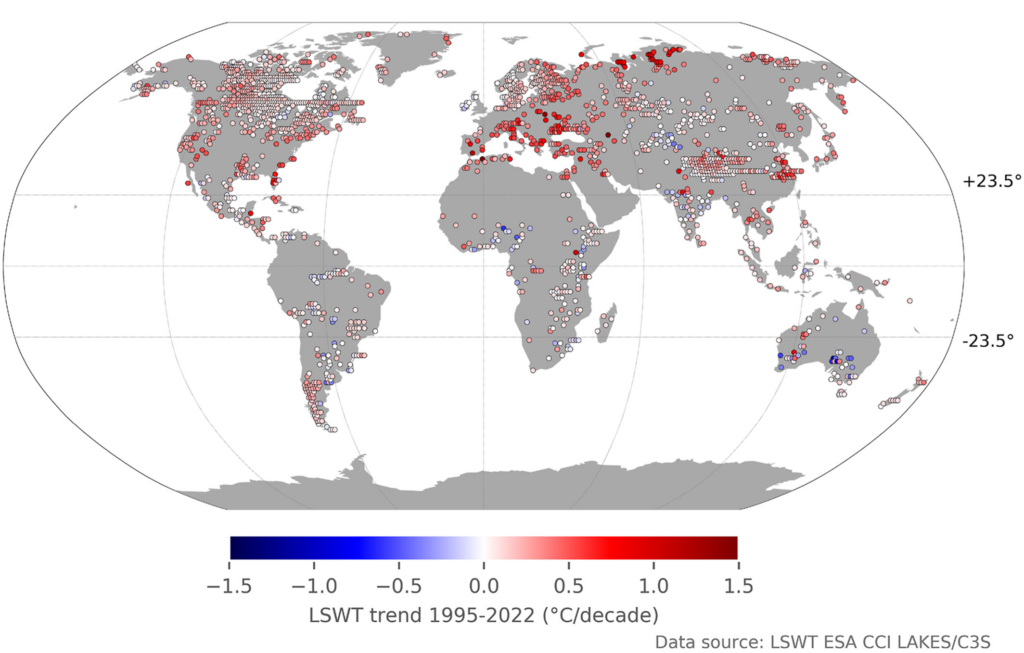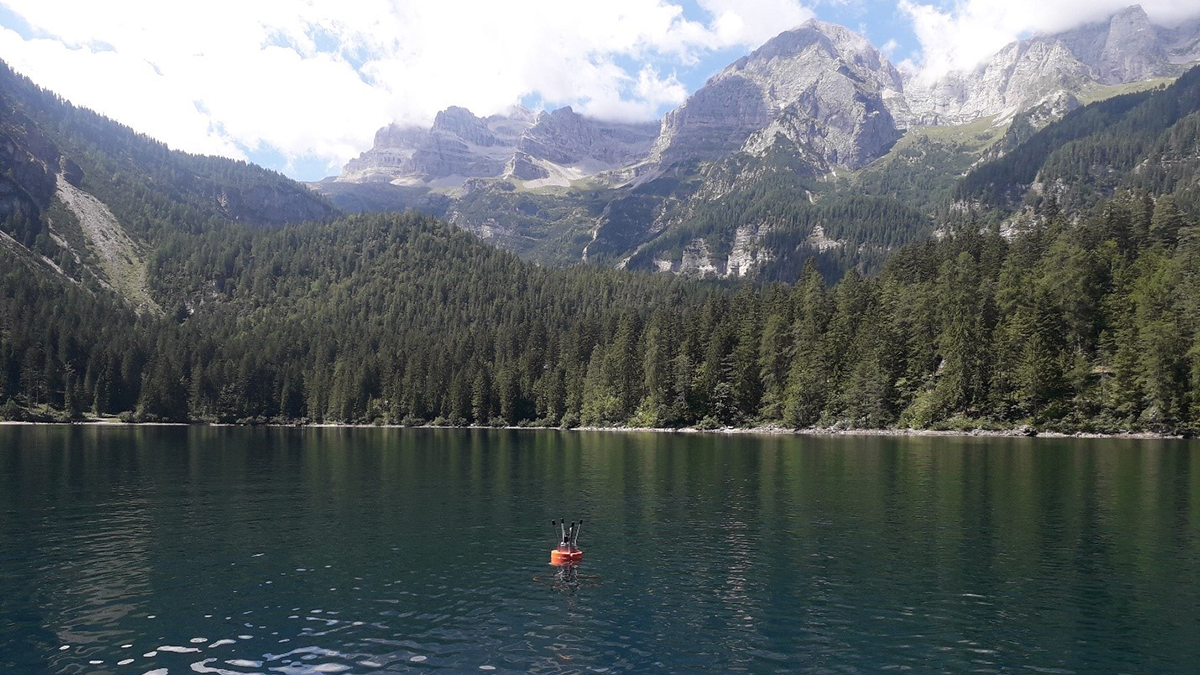Editors’ Vox is a blog from AGU’s Publications Department.
Lakes are a fundamental component of the hydrosphere and store about 87% of the Earth’s liquid surface freshwater resources. The temperature dynamics within lakes are important to understand and model, especially as climate change progresses, since they shape mixing processes and the health of aquatic ecosystems.
A new article in Reviews of Geophysics explores the different components and techniques used in lake water temperature modeling. We asked the authors to give an overview of lake temperature dynamics, the successes and challenges of modeling these dynamics, and what new approaches are emerging.
In simple terms, why are lakes important in the Earth system?

Lakes, particularly the largest ones, have higher thermal inertia and longer residence times than those of other inland water bodies and therefore act as important buffers against various external pressures induced by anthropogenic activities and climate change. They actively participate in the carbon cycle, acting either as carbon sinks or sources, thereby playing a significant role in climate regulation. For example, lakes are major emitters of methane to the atmosphere, but they also contribute to carbon sequestration by using atmospheric carbon dioxide in photosynthesis and by burying organic carbon into sediments.
Additionally, lakes help to regulate local climates by moderating temperature fluctuations and influencing weather patterns. Lakes are rich in biodiversity and support diverse ecosystems that are vital for a wide range of plant and animal species, provide recreational opportunities and play a key role in supporting local economies in a variety of sectors, including tourism, agriculture, energy, and other industries.
What are some of the expected impacts of climate change on lakes?
Climate change, coupled with human activities, is having a significant impact on lakes worldwide. The progressive shrinking of lakes, fueled by overexploitation of water resources and a global decline in lake water storage, is of particular concern, especially in arid regions.
Lakes worldwide are already experiencing rapid changes in water temperature, ice cover, and water quality.
Lakes worldwide are already experiencing rapid changes in water temperature, ice cover, and water quality, which may lead to shifts in thermal and mixing patterns. These changes affect the distribution of nutrients and oxygen critical for ecosystem processes, increasing the risk of cyanobacterial blooms and habitat loss for native cold-water species. In addition, such changes often facilitate the establishment of invasive species.
It is therefore crucial to implement sustainable environmental practices and adaptation strategies to mitigate the effects of climate change on lakes, and lake models play a key role in understanding potential scenarios and guiding management decisions.
Why is water temperature useful for assessing the impacts of climate change on lakes?
Water temperature is a key physical indicator for understanding the health of a lake ecosystem. Animals, plants, and other organisms only thrive within certain temperature ranges. Higher than normal temperatures can have a variety of negative impacts on lakes, including stressing native organisms with temperatures beyond their optimal ranges, triggering the establishment of invasive species, and altering mixing patterns which can reduce dissolved oxygen in a lake, affecting and ultimately eliminating aquatic life.
Long-term records of water temperature, dating back to the mid-20th century, provide valuable insights into past and present lake conditions and aid in predictive modelling of future trends.
While in-situ measurements have limitations, satellite Earth observation data provide a global perspective and enable comprehensive monitoring of lake surface water temperature (LSWT). Advances in satellite technology and data processing methods have greatly improved the reliability and accessibility of LSWT data, contributing to a deeper understanding of the impact of climate change on lakes worldwide. LSWT is recognized as an essential climate variable by the Global Climate Observing System, as it is central to characterizing the climate system and its changes.

How has the development of mathematical models advanced our understanding of lake temperature dynamics?

The development of mathematical models significantly improves our understanding of lake temperature dynamics.
These models integrate empirical data and theoretical principles that help to analyze past trends and current conditions, identify key drivers of temperature dynamics, and then quantify potential future changes due to climate change and anthropogenic stressors.
As a result, mathematical modeling serves as a valuable decision-making tool in lake management and conservation efforts, facilitating the development of effective strategies to mitigate environmental degradation and conserve freshwater resources.
The limnological community has played a central role in the development of water temperature models, taking advantage of the increasing availability of data and advances in computational technology to refine our knowledge of lake dynamics.
What are the main limitations of these models?
Models are imperfect representations of reality. This is due to a number of factors such as uncertainties in the data and the necessary simplification of real-world processes into mathematical equations. Modelers face the challenge of solving these equations numerically at specific temporal and spatial resolutions, potentially overlooking processes occurring at different scales.
While the physical processes that affect water temperature are generally well described mathematically, biological feedback mechanisms such as algal growth, which is temperature dependent and affects water clarity, which in turn affects water temperature, pose modelling challenges. Capturing these feedbacks is a notable challenge and is essential for making reliable projections into the future. It should be noted that both data-driven and process-based models may have difficulty in predicting unforeseen conditions, highlighting the need for further research in this area.
What new or emerging approaches are being used to optimize these models?
Several innovative methods are emerging to improve lake temperature models.
Digital twins, virtual replicas of real lakes, are proving valuable for management, allowing scientists to simulate lake behavior under different conditions and refine prediction accuracy.
Ensemble modeling uses multiple models to overcome individual limitations, providing a comprehensive assessment of temperature responses to external forcing.
In addition, promoting bidirectional coupling between lake and climate models can integrate complex interactions between lakes and surrounding climate systems.
These advances contribute significantly to improving our understanding and predictive capabilities, thereby improving management and conservation strategies for freshwater ecosystems.
Finally, the increasing popularity of hybrid models, which blend data-driven machine learning with traditional mechanistic models, reflects the recent evolution of modeling techniques.
All these advances contribute significantly to improving our understanding and predictive capabilities of lake temperature dynamics, thereby improving management and conservation strategies for freshwater ecosystems.
—Sebastiano Piccolroaz ([email protected], ![]() 0000-0003-1796-7624), University of Trento, Italy; Senlin Zhu, Yangzhou University, China; Robert Ladwig (
0000-0003-1796-7624), University of Trento, Italy; Senlin Zhu, Yangzhou University, China; Robert Ladwig (![]() 0000-0001-8443-1999), Aarhus University, Denmark; Laura Carrea (
0000-0001-8443-1999), Aarhus University, Denmark; Laura Carrea (![]() 0000-0002-3280-2767), University of Reading, United Kingdom; Samantha Oliver (
0000-0002-3280-2767), University of Reading, United Kingdom; Samantha Oliver (![]() 0000-0001-5668-1165 ), United States Geological Survey; Adam P. Piotrowski, Polish Academy of Sciences, Poland; Mariusz Ptak (
0000-0001-5668-1165 ), United States Geological Survey; Adam P. Piotrowski, Polish Academy of Sciences, Poland; Mariusz Ptak (![]() 0000-0003-1225-1686), Adam Mickiewicz University, Poland; Ryuichiro Shinohara (
0000-0003-1225-1686), Adam Mickiewicz University, Poland; Ryuichiro Shinohara (![]() 0000-0003-2716-3312), National Institute for Environmental Studies, Japan; Mariusz Sojka (
0000-0003-2716-3312), National Institute for Environmental Studies, Japan; Mariusz Sojka (![]() 0000-0002-1453-0374), Poznań University of Life Sciences, Poland; Richard I. Woolway (
0000-0002-1453-0374), Poznań University of Life Sciences, Poland; Richard I. Woolway (![]() 0000-0003-0498-7968), Bangor University, United Kingdom; and David Z. Zhu (
0000-0003-0498-7968), Bangor University, United Kingdom; and David Z. Zhu (![]() 0000-0002-7714-0373), University of Alberta, Edmonton, Canada
0000-0002-7714-0373), University of Alberta, Edmonton, Canada
Citation: Piccolroaz, S., S. Zhu, R. Ladwig, L. Carrea, S. Oliver, A. P. Piotrowski, M. Ptak, R. Shinohara, M. Sojka, R. I. Woolway, and D. Z. Zhu (2024), Challenges and prospects for modeling lake water temperature in a changing climate, Eos, 105, https://doi.org/10.1029/2024EO245013. Published on [DAY MONTH] 2024.


